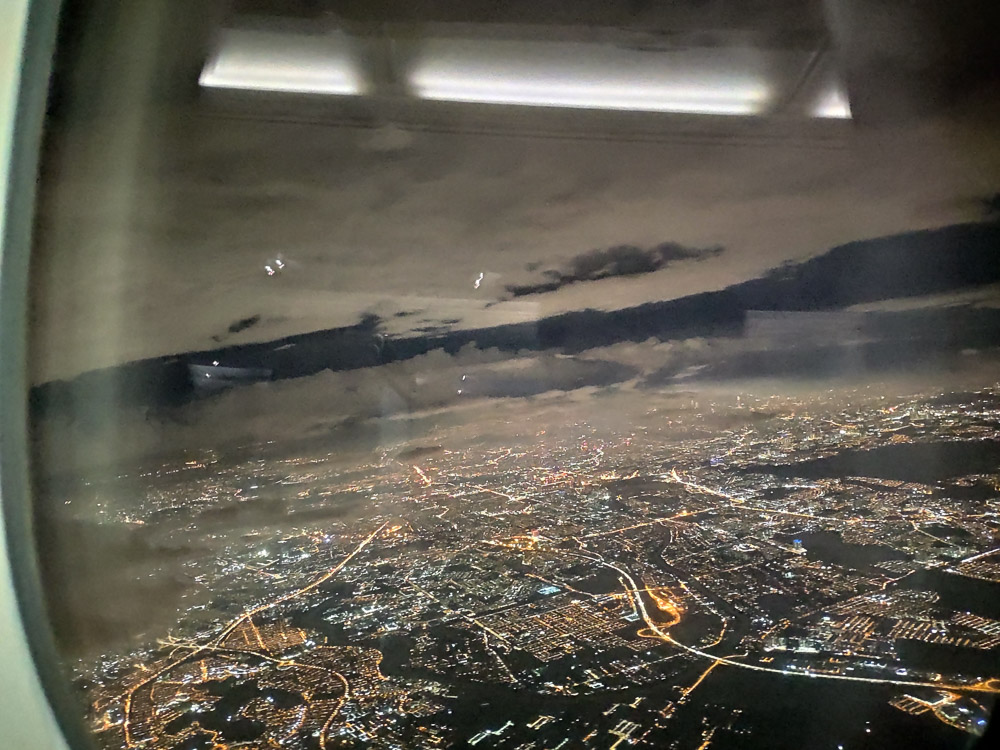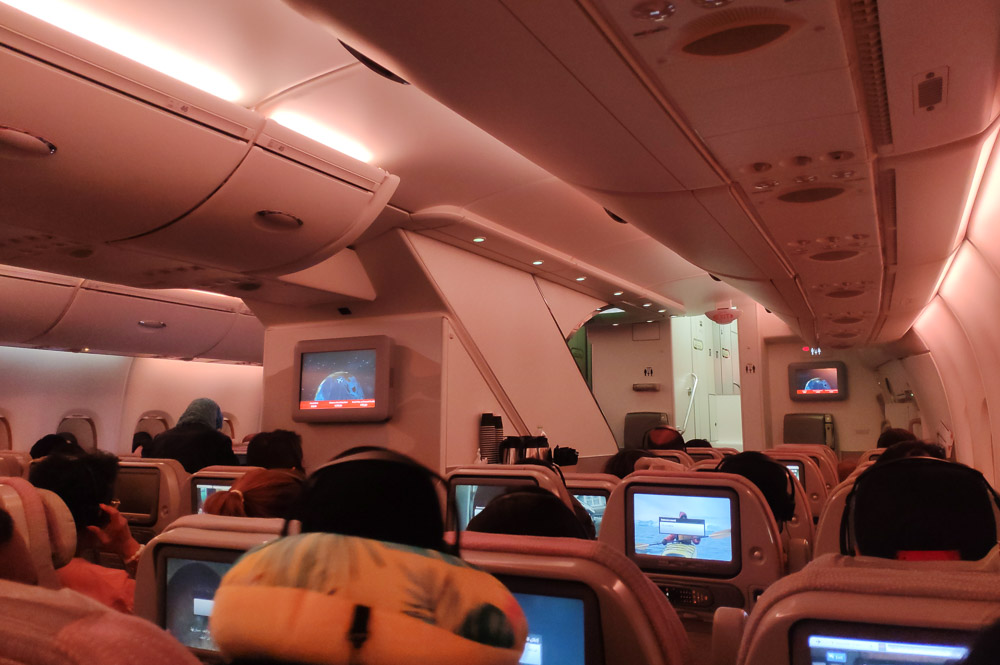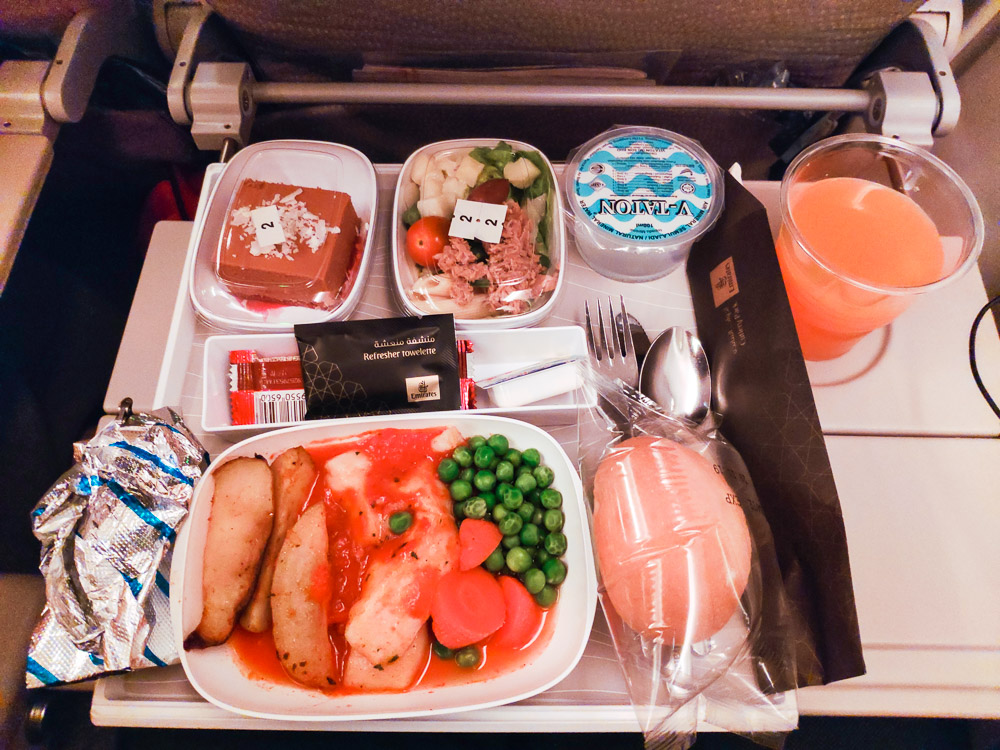Emirates is one of the world’s major airlines. The location of its hub in Dubai makes it a natural stopover point for airlines seeking to refuel, as well as for travelers who prefer splitting their travel leg into two, more manageable segments. This, combined with a reliance on the economics of scale, has made Emirates the natural choice for flying to most parts of the world.
Despite its size and prominence, throughout my 3 years of flying back and forth between Malaysia and the UK, I’ve managed to avoid EK altogether and relied solely on direct, 13 -14 hour flights. A winter season trip to England in November 2019, however, provided just the opportunity to sample this big airline.
First posted 3 February 2020. Updated 4 March 2023.
Departure experience from Kuala Lumpur International Airport
Emirates offers 3 flights a day from Kuala Lumpur to its Dubai hub. These are timed at 01:45 am, 10:15 am, and 07:10 pm respectively. Our flight EK 347, operated by an Airbus A380, is the 07:10 pm flight out of KUL, and makes for a relatively less rushed experience than, say, a morning flight requiring you to be at the airport at 7 in the morning.
We had already checked in online, so it was a simple matter to join the queue for the bag drop and boarding pass collection.

Kuala Lumpur International Airport is in its twenties having opened in 1998, and it did seem to show its age more prominently compared to its older regional counterparts. Nonetheless its architecture is quite timeless and modern, and is still a sight to behold.

Having dropped the bags, we then headed straight down to departure immigration. MAHB is in the process of installing a single token system on par with other major airports, and new facial recognition gates were installed just before the escalators down to the immigration area. These are not functional yet, however, and you still need to show your passport and boarding pass to the friendly uniformed officer.
The immigration queue was sparse, not that it mattered for me as I could make use of the autogates, which incidentally had been upgraded. These worked faster than their predecessors which often felt painfully slow. A minute on the gates and I was through to the departure area.


Most international flights from KUL depart from the satellite terminal, which requires a trip on the stuffy Aerotrain. These Bombardier APM 100 units have been running since the complex opened in 1998, and their replacements don’t seem to be arriving anytime soon.
Plaza Premium Lounge @ KUL Satellite Terminal
With some time to spare, we headed to the Plaza Premium Lounge for some nibbles. The Lounge is usually quite busy and ideal seating can be hard to find. While the food quality is pretty decent the spread is limited compared to lounges run by legacy carriers. Still, it’s a pretty good alternative especially if you’re flying on an economy ticket.

One nagging point, however, is that staff can take some time to clean up used plates and mugs, which adds a bit of a mess to the setting.
Boarding the Emirates Airbus A380
Our flight was to be operated by A6-EDL, a 9 year old Airbus A380 and member of Emirates 115-strong A380 fleet, and set to depart from Gate C27. Gate C27 is one of the 3 gates in KUL equipped for A380 handling, featuring a dual-level waiting area and 3 aerobridges – 2 for the lower deck and 1 for the upper.


It also features perhaps one of the worst seats you’ll ever find in a major international airport.

Boarding was called and we duly trooped into the Airbus. This particular aircraft saw all its economy seats on the lower deck with the premium classes on the upper deck. For ease of access, we booked seats in the front cabin of the aircraft. Given that the front cabin is small, it gave a somewhat private feeling in what is quite literally an Air Bus.


The doors closed late, right on our stated departure time and we began the pushback and taxi to runway 32R. Due to traffic, we were held up in a queue until 7:48 pm when we finally took off.

Cabin & Onboard Amenities
Emirates outfits its A380s in slightly different configurations, with the Economy Class seats ranging from the first generation to the latest. This particular aircraft saw all its Economy seats on the lower deck with First and Business Class on the upper deck. For ease of access, we booked seats in the front cabin of the aircraft. Given that the front cabin is small, it gave a somewhat private feeling in what is quite literally an Air Bus.


Emirates has added its personal touch to the trimmings of the cabin, with a preponderance of faux wood trimmings in the toilets and the window frames. I’m not a big fan of these, but it works well in creating that Emirates ambience onboard.

The Airbus A380’s famous big window frames were also on full display, but were fixed at an angle to the actual (smaller) window porthole. This gives an impression of bigger windows, but the angle means some difficulties getting a good view out of the window.
Emirates Airbus A380 1st generation Economy Class seats
Emirates’ Airbus A380 Economy cabin is configured in a 3-4-3 layout, with 32 inches of seat pitch.


This particular aircraft was fitted with the airline’s 1st generation A380 Economy Class seats, and were the best I’ve experienced so far. The padding was comfortable enough to give me a good night’s sleep, and the seats were also slightly wider than your standard economy seat – perks of flying on an A380. This was a welcome change from the British Airways Economy Class seats on their 787s, which at times felt somewhat cramped and underwhelming.
Each seat was outfitted with a 12.1 inch resistive touch screen for the IFE, and also featured a power outlet, a USB port, and a small coat hook. The requisite IFE remote control was also affixed in its cradle, but was of the older type with more physical buttons and a QWERTY keyboard on the back.
Inflight Amenities – Emirates ICE inflight entertainment
Emirates’ inflight entertainment system is branded “ICE“, and is well known for its huge selection of content. ICE also feature views through cameras installed on the exterior of the aircraft, which were pretty cool during take-off and landing. The ones on the A380 are unfortunately older cameras, and aren’t very sharp.

Headsets were distributed by the cabin crew after takeoff. These work decently, but they aren’t really that fantastic either. I had some trouble hearing the audio coming through the headsets, and had to turn the volume up higher.

I already had a long day before the flight, and so I elected to ignore the inflight entertainment and went straight to sleep.
Onboard Catering
The menu for the inflight meal service was handed out by cabin crew during the final stages of boarding at KUL. This gave passengers plenty of time to decide on their choices. I quite liked getting the paper menus, as my previous flights on legacy airlines either flashed the menu on the IFE screens, or had no menus at all.

The meal service for this flight was to consist of a dinner service, and a breakfast service before arrival at DXB.
Emirates KUL – DXB Dinner service
The dinner service began around 2 hours after departure from KUL. I chose the Grilled Perch with Red Pepper Sauce, but wasn’t entirely sure what to expect.

I ended up being pleasantly surprised with the quality of the meal. The fish and potatoes were nicely cooked and not overdone. The flavours of the main dish remained intact, although the “Red Pepper Sauce” wasn’t as spicy as I had hoped for. The accompanying desserts and bread were also enjoyable, although I found the side salad a little odd.
Emirates KUL – DXB Breakfast service
Passengers were offered a choice “cheddar with tomato chilli relish” or “smoked chicken with pesto mayonnaise sandwich” for the Breakfast service, together with a choice of coffee or tea.

I chose the sandwich and a cup of coffee as my breakfast. They tasted alright, but my taste buds hadn’t quite woken up yet at the time. It was also nice to see that passengers were woken up for their breakfast service by the flight attendants.
Arrival at Dubai International Airport
The descend and approach started while breakfast was served, and soon we’d crossed the Oman-UAE border on a final approach into DXB.

Touchdown on the A380 was smooth, and I had my first look at the scale of DXB. Despite it being a relatively quiet hour for the airport there were still quite a number of planes on the tarmac.

With a 4 hour transit looming before my next flight, I picked up my bags and headed into the belly of DXB’s huge Concourse A.
Final Thoughts
This was a good first introduction to Emirates and its A380 service, and left me keen to see how the airline would hold up on my next sector with them to London Gatwick.

Leave a Reply